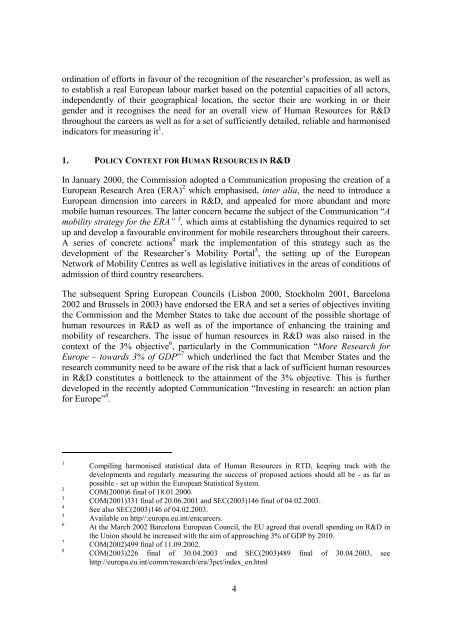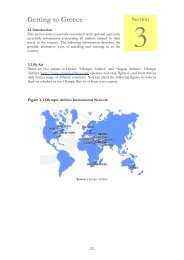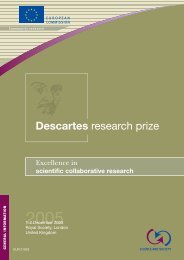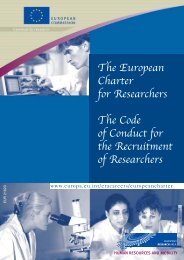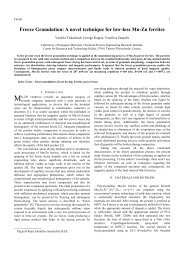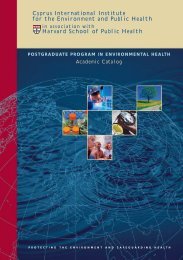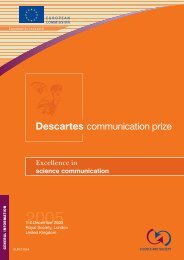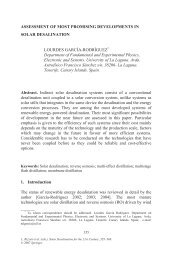Researchers - Bologna-Berlin 2003
Researchers - Bologna-Berlin 2003
Researchers - Bologna-Berlin 2003
- No tags were found...
Create successful ePaper yourself
Turn your PDF publications into a flip-book with our unique Google optimized e-Paper software.
ordination of efforts in favour of the recognition of the researcher’s profession, as well asto establish a real European labour market based on the potential capacities of all actors,independently of their geographical location, the sector their are working in or theirgender and it recognises the need for an overall view of Human Resources for R&Dthroughout the careers as well as for a set of sufficiently detailed, reliable and harmonisedindicators for measuring it 1 .1. POLICY CONTEXT FOR HUMAN RESOURCES IN R&DIn January 2000, the Commission adopted a Communication proposing the creation of aEuropean Research Area (ERA) 2 which emphasised, inter alia, the need to introduce aEuropean dimension into careers in R&D, and appealed for more abundant and moremobile human resources. The latter concern became the subject of the Communication “Amobility strategy for the ERA” 3 , which aims at establishing the dynamics required to setup and develop a favourable environment for mobile researchers throughout their careers.A series of concrete actions 4 mark the implementation of this strategy such as thedevelopment of the Researcher’s Mobility Portal 5 , the setting up of the EuropeanNetwork of Mobility Centres as well as legislative initiatives in the areas of conditions ofadmission of third country researchers.The subsequent Spring European Councils (Lisbon 2000, Stockholm 2001, Barcelona2002 and Brussels in <strong>2003</strong>) have endorsed the ERA and set a series of objectives invitingthe Commission and the Member States to take due account of the possible shortage ofhuman resources in R&D as well as of the importance of enhancing the training andmobility of researchers. The issue of human resources in R&D was also raised in thecontext of the 3% objective 6 , particularly in the Communication “More Research forEurope – towards 3% of GDP” 7 which underlined the fact that Member States and theresearch community need to be aware of the risk that a lack of sufficient human resourcesin R&D constitutes a bottleneck to the attainment of the 3% objective. This is furtherdeveloped in the recently adopted Communication “Investing in research: an action planfor Europe” 8 .12345678Compiling harmonised statistical data of Human Resources in RTD, keeping track with thedevelopments and regularly measuring the success of proposed actions should all be - as far aspossible - set up within the European Statistical System.COM(2000)6 final of 18.01.2000.COM(2001)331 final of 20.06.2001 and SEC(<strong>2003</strong>)146 final of 04.02.<strong>2003</strong>.See also SEC(<strong>2003</strong>)146 of 04.02.<strong>2003</strong>.Available on http//:europa.eu.int/eracareers.At the March 2002 Barcelona European Council, the EU agreed that overall spending on R&D inthe Union should be increased with the aim of approaching 3% of GDP by 2010.COM(2002)499 final of 11.09.2002.COM(<strong>2003</strong>)226 final of 30.04.<strong>2003</strong> and SEC(<strong>2003</strong>)489 final of 30.04.<strong>2003</strong>, seehttp://europa.eu.int/comm/research/era/3pct/index_en.html4


